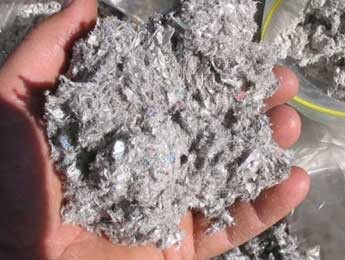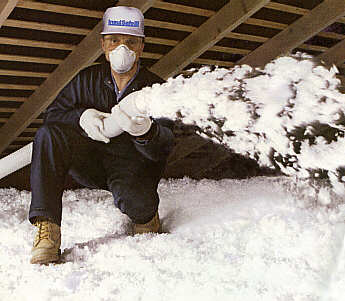Cellulose Insulation
Four major types of loose-fill cellulose products have been developed under a variety of brand names. These are generally characterized as dry cellulose, spray applied cellulose, stabilized cellulose, and low dust cellulose. These types are used in different parts of a building and for different reasons.
Dry cellulose (loose fill)
Dry cellulose is used in retrofitting old homes by blowing the cellulose into holes drilled into the tops of the walls. It can also be blown into a new wall construction by using temporary retainers or netting that is clamped in place then removed once the cellulose has reached the appropriate density. This form of application does settle as much as 20% but the stated R-value of the cellulose is accurate after settling occurs. In addition, a dense-pack option can be used to reduce settling and further minimize air gaps. Dense-pack places pressure on the cavity, and should be done by an experienced installer.
Loose fill in walls is an antiquated technique of using cellulose in wall cavities. The home performance industry and its accrediting bodies support the dense-pack standard of insulating wall cavities, which does not settle. This method stops the stack effect and convective loops in wall cavities.
Spray-applied cellulose (wet-spray cellulose)
Spray-applied cellulose is used for applying cellulose to new wall construction. The differences are the addition of water to the cellulose while spraying as well as adding some kind of moisture retardant such as chlorine to prevent mold cultures. In some cases the insulation might also mix in a very small percentage of adhesive or activate a dry adhesive present in the cellulose. Wet-spray allows application without the need for a temporary retainer. In addition, wet-spray allows for an even better seal of the insulated cavity against air infiltration and eliminates settling problems. Wet-spray installation requires that the wall be allowed to dry for a minimum of 24 hours (or until maximum of 25% moisture is reached) before being covered.
Stabilized cellulose
Stabilized cellulose is used most often in attic/roof insulation. It is applied with a very small amount of water to activate an adhesive of some kind. This reduces settling and decreases the amount of cellulose needed. This can prove advantageous at reducing the overall weight of the product on the ceiling drywall helping prevent possible sag. This application is ideal for sloped roofs and has been approved for 5:12 (41.66%) slopes.
Low-dust cellulose
The last major type of cellulose insulation on the market is low-dust variety. Nuisance levels of dust are created during application of most types of dry insulation causing the need for simple dust masks to be worn during installation

